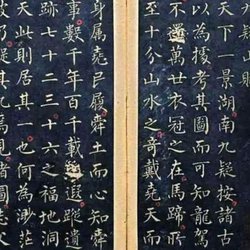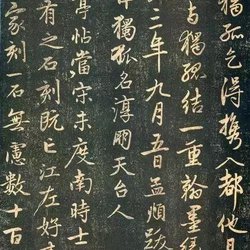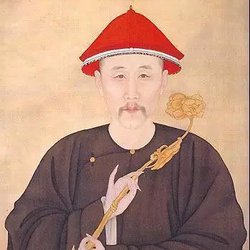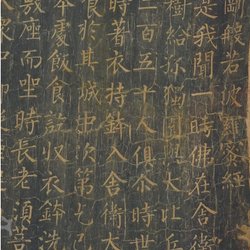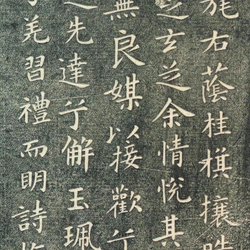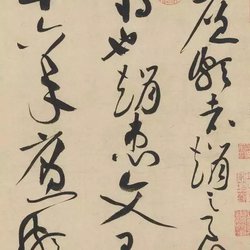Liu Gongquan served in seven dynasties including Xian, Mu, Jing, Wen, Wu, Xuan, and Yi dynasties. He rose to the rank of Prince Shaoshi, and was granted the title of Duke of Hedong County. He became an official as Prince Taibao, and was known as "Liu Shaoshi" in his later life. Liu Gongquan created his own "Liu Ti", which was famous for its strong bones and strong bones. Later generations had the reputation of "Yan Jin Liu Gu". Liu Gongquan is also a poet. Five of his poems are preserved in "The Complete Poems of the Tang Dynasty" and one poem is preserved in "The Complete Poems of the Tang Dynasty". Below is a selection of Liu Gongquan’s regular script calligraphy compiled by the editor for you. I hope it will be useful to you!
Appreciation of Selected Regular Script Calligraphy of Liu Gongquan
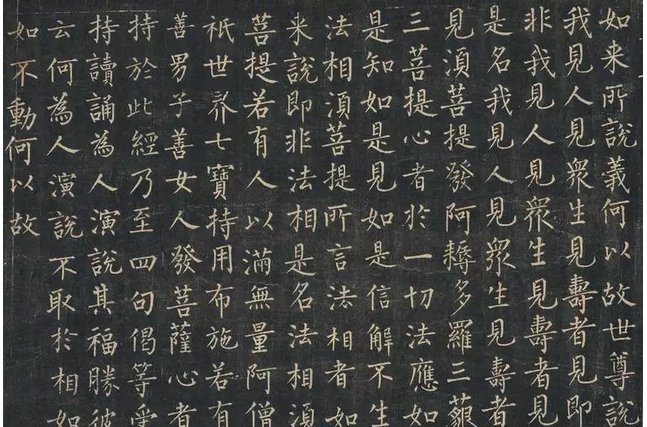
Liu Gongquan's personal profile
Liu Gongquan (778-865), courtesy name Chengxuan, Han nationality, was born in Jingzhao Huayuan (now Yaoxian County, Shaanxi Province) in the Tang Dynasty and was a famous calligrapher. Liu Gongquan was eager to learn when he was young, good at diction and poetry, and understood rhythm. He rose to the rank of Prince's Shaoshi, and was known as "Liu Shaoshi" in the world. Later, Duke Liu was granted the title of Duke of Hedong County, also known as "Liu Hedong". Gongquan was the successor of Yan Zhenqing, but his calligraphy style was unique. Later he was known as "Yan Liu" and became a model of calligraphy in the past dynasties.
He first learned calligraphy from Wang Xizhi. Later, he looked at the calligraphy of famous calligraphers of the Tang Dynasty and thought that the calligraphy of Yan Zhenqing and Ouyang Xun was the best, so he absorbed the strengths of Yan and Ou, and formed his own style between the Jin people's charm and Yan's calligraphy. Willow body is famous for its strong bones and is known as "Yan Jin Liu Gu" in later generations. He created many works in his life, mainly including "Inscription on the Bell Tower of the Huiyuan Temple of the Tang Dynasty", "Stone Engraving of the Diamond Sutra", "Mysterious Pagoda Stele", "Feng Su Stele", and "Shence Army Stele". There are also ink inscriptions "Mengzhao Tie" and "Wang Xianzhi's postscript to send pears".
Pointillism writing method in regular script
There are many calligraphers who are good at regular script in Chinese history, and their calligraphy works have different styles. Comrades who are new to regular script should first learn the basic writing methods of dot, horizontal, vertical, left, N, and hook, etc., and then according to their own hobbies, they can Choose your favorite inscriptions to copy. After a period of practice, the stipples and structure you write will gradually come close to the inscriptions you are reading.
Here is a list of basic stipple writing methods:
1. The hidden edge method of skimming: the writing method of putting down the pen, folding the pen and dot writing is roughly the same, and then gradually lift the pen to the left and skim out, the speed should not be too fast or too slow. If it is too fast, the tail will be too sharp and too thin, which will form a "rat tail" of the diseased pen, and the length of the strokes will be difficult to control; if it is too slow, the tail will be blunt and without edge.
2. The exposed-edge method is to drop the pen tip straight down, and then adjust the pen tip to center out.
3. The horizontal method of hiding the front: start writing against the front - if you want to go right, first go left. When you reach the left end, fold the pen and pause, then gently lift the pen and use the center forward to move to the right. When the length and length are combined, first lift the pen lightly and use the side edge to write the edge of the upper right end. , then pause the pen, and when it reaches the lower right end, turn the pen to the left and close it.
4. The exposed edge method is to move the pen to the lower right and as soon as it lands on the paper, use the center edge to move to the right immediately. The rest of the pen lifting, pen stopping, and pen closing are the same as the hidden edge method. When using the exposed edge method to write a horizontal stroke, special attention should be paid to not cutting the edge too far to the lower right, otherwise the left end of the horizontal stroke will be thin and empty.
5. The method of hiding the point: start the pen against the front - if you want to go down, go up first, fold the pen at the top, do not use the turning method, as the top will not be sharp when turning, then draw the pen to the lower right, turn the pen to the lower left of the bottom, and finally to the upper left Fang put away his pen. The shape of the point is pointed at the top and rounded at the bottom, with a flat belly (on the left) and a rounded back (on the right).
6. The exposed edge method is to write straight down along the edge - this writing method is also called cutting edge. The rest of the strokes and closing strokes are the same as the hidden edge method.
7. The method of hiding the front of the hand: start the pen against the front - if you want to move forward, turn the pen left first, then turn the pen upward (like drawing a circle with a compass, or like drawing half a small dot with a brush), then immediately go down to the right and gradually press the pen The strokes are gradually thickened, the stroke is stopped when the stroke is coming, and finally the stroke is lifted to strike. The whole process of writing can be summarized as "reverse in and level out". Flat out means that there should be no folded corners when bending the corners.
The steeper one is called Zongna, also known as Jin Dao, and is used in characters such as wood, ben, lai, and shi; the flatter one is called horizontal Na, also known as swimming fish, and is used for walking. If the first end of the stroke is connected to other strokes without being exposed, the stroke can start smoothly but not in reverse.
8. The exposed front method of the horizontal stroke is to follow the front straight down, and then the side forward goes up. The rest of the strokes, stationary strokes, and forward moves are the same as the hidden front method.
There are differences between hanging needles and hanging dews. If the lower part of the pen is closed in a dew-drop shape, it is called a hanging needle. If the hanging part is pointed and sharp like a needle, it is called a hanging needle.
9. The method of hiding the pen with a hanging and vertical pen: start the pen against the front, fold the pen downward, adjust the pen edge to a center downward direction, when the length and length are combined, lift the pen slightly and turn it back to the left (or right) to close the pen.
10. The exposed-edge method is to cut the edge straight down, adjust the pen edge to a center stroke, and the rest of the strokes are the same as the hidden-edge method.
11. For the hidden-edge method and the exposed-edge method of hanging the needle vertically, the starting point and stroke of the pen are the same as that of the hanging needle. When the length and length of the pen are combined, the pen is slowly raised and the edge is drawn. The speed is similar to that of the tipping, but slower than the tipping. Because the hanging needle is upright like a mainstay, and the center is not straight, if the front is moved too fast, it may be skewed or floated. The most difficult thing about hanging needle is to write it without leaning or slanting, just like an iron pillar standing upright but not stiff. Beginners can master it only by studying hard and practicing hard.
1. Hooks have the most changes. Here we will talk about the two most basic types - left hook and right hook.
Both the left hook and the right hook are attached to the vertical hook. When reaching the bottom of the hook, lift the pen slightly downward to the left (so that an edge appears on the right side of the hook). When reaching the bottom of the hook, lift the pen to the left to form a left hook. The right hook and left hook strokes are the same, but in opposite directions. There is another kind of right hook, which looks like it is written in two strokes, which is called Qiao hook. It is used for characters such as Chen and Shi that have Chang Na or Chang Ge on the right side. The way to write it is, when you are about to write a hook when the length and length are equal, you should first stop the pen, then lift the pen to the left, fold the pen, pause, and finally lift the pen to pick out.
After learning the left hook and right hook, you can further learn the lion's mouth, phoenix wings, treasure cover, dragon tail, straight attack, horizontal attack, etc.
The way to write the lion's mouth is as follows: use the pen as if writing a horizontal stroke. When you reach the turning point, lift it first and then pause it. Adjust the tip of the pen to the center and stroke downward to the left. When the length and length are combined, the nose pen points upward. Lift the pen and draw it out. The lion's mouth method is used for words such as Ju, Yun, Shu, Nan, Ma, and Wei.
The writing method of Phoenix Wings is: use the pen as if to draw horizontally, lift first and then pause at the turning point, adjust the stroke to the center, and then use the center stroke as if to make a circle according to the rules. When the length and length are combined, the stroke will be drawn out. When writing phoenix wings, it is required that the turning point and the hook point should be thicker, and the middle part should be thinner. The phoenix wing method is used for words such as wind and phoenix.
The writing method of Baogai is divided into square pen style and round pen style:
1. Square stroke style: Use the pen as if you were drawing horizontally. When you reach the turning point, lift first and then pause. Then, return to the turning point and then lay out the hook using the center or side forward.
2. Round pen style: Use the pen as if you were drawing horizontally. When you reach the turning point, lift first and then pause. Use the center to swing to the turning point to draw the hook. This method is often seen in willow body.
Regardless of the square pen style or the round pen style, the hook should be flat rather than hanging so as to echo the part under the treasure cover. Baogai method is used for words such as Kong, Bao, Yu and Guan.
The way to write the dragon's tail is: use the pen as if you were drawing vertically, make a circle when turning, and turn the tip of the pen as you go. After passing the bend, use the pen as if you were drawing horizontally. When the length and length are combined, look at the pen and pick out the hook.
The bends of the dragon's tail should be curved except for the European body, and should not be square corners. The brush should be moved slightly faster here to express the power of the iron painted silver hook. After the bend, the part that is like a horizontal drawing should be slightly upturned and not drooped. If it droops, it will give a feeling of slackness. Dragon tail is used in characters such as Ye, Yuan, Jian, and Bi.
The writing method of Zhi Ge is: start the pen vertically, and then draw the pen to the lower right. When the long and short lengths are combined, the front edge of the pen hooks to the upper right.
When writing Zhi Ge, the upper and lower sections should be slightly straight and thick, while the middle section should be slightly curved and thin. Just like the human body, if the shoulders are wide and the hips are plump and the waist is slim, it will look strong, while if the waist is thick and the shoulders and hips are narrow, it will look clumsy. The straight line should not be too straight or too curved. Too straight will appear stiff, and too curved will appear weak. The key is to balance hardness and softness. Zhige is used in the words Ge, Wu, Cheng, Sheng, etc.
The writing method of Heng Ge is: draw the pen straight along the front to make it sharp, and follow the rules to make a circle. Stop when the pen is like a crescent, and then draw the hook to the upper left.
The hook should be curved rather than straight, short rather than long, and the hook should be slightly longer than the dragon's tail. The hook is used for words such as heart and bi.

